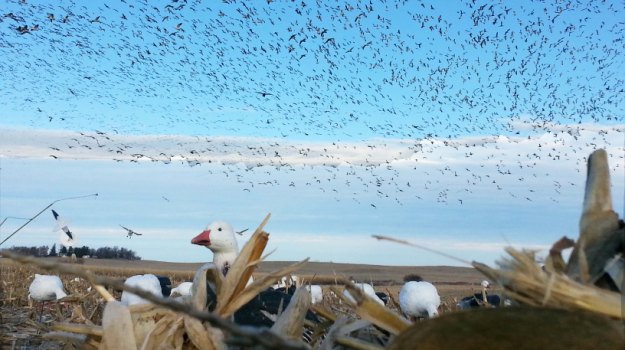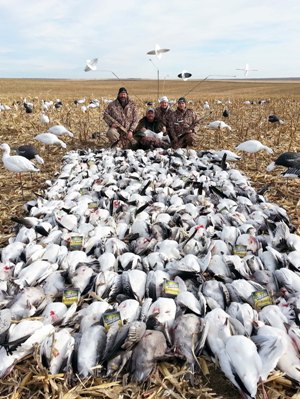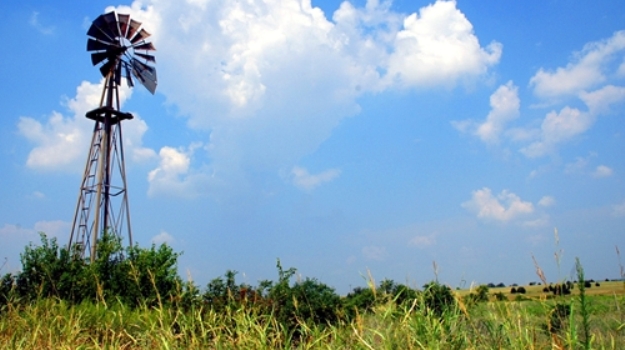
Editor’s Note: Jason Patterson from Jackson, Tennessee, has been hunting waterfowl for more than 20 years and is the original ProStaff Manager for waterfowl on the Mississippi flyway. He primarily guides in northeast Arkansas and west Tennessee.
Our snow goose season in Tennessee runs through March 10, 2015. The best snow goose hunting is in the northwestern part of Tennessee in the Reelfoot area, or we can go across the Mississippi River and hunt in northeast Arkansas, where the snow goose season is February 2 through April 25, 2015. I have several friends and Mossy Oak ProStaff members who live in Arkansas, so I often go there to hunt snow geese with them. To have a successful snow goose hunt requires a lot of scouting. You need to know where the snow geese are feeding every day, but after you locate the geese, getting permission to hunt on those farms is relatively easy. The farmers want to you to take as many as you can because the snow geese destroy their fields. I have friends who live and work in northeastern Arkansas who are constantly checking fields and looking for snow geese. When they see large flocks of snow geese feeding in the same field for 2 or 3 days, they’ll give me a call and say, “We’ve got some big flocks of snow geese spotted. Come over tomorrow, and we’ll take as many snow geese as we can.”
The rule of thumb on hunting snow geese is to put out as many decoys as possible - generally 200 to 500 snow goose decoys. The majority of snow goose decoys we use will be the wind sock style decoys. We’ll also put out from 50 to 100 full body decoys, and in addition. we use spinning wing decoys like the Reel Wings motion decoys. The Reel Wings version decoys turn with the wind. The rotary part of the decoy runs off a battery, and the wings attach to this decoy. We also use an electronic caller that’s made by Reel Wings. One of the advantages of the Reel Wings Electronic Caller is that you can put out two or four speakers. By having more than one speaker, you can put the other speakers in different areas of your decoys. Then the sounds the speakers put out make your spread sound like different parts of the flock calling. If you run four speakers at one time you can put out a wall of sound that’s very effective to call in a big flock of snow geese. You can get either wireless speakers or speakers with wires that plug into the caller.
Most of the snow geese that we take in February and March are headed back to the nesting grounds in Canada. We can use electric callers and unplugged shotguns then, in the Conservation Season, because snow geese have multiplied so rapidly that they’re destroying their own habitat and nesting areas of Canada. The flocks of snow geese we usually see will number from 50 to 500 per flock. In a morning hunt, we’ll generally have 10 to 15 flocks of snow geese come into our decoy spread, depending on the hunting and the weather conditions. If you’ve never hunted snow geese, you really need to plan a trip during February or March, because just to witness 500 or more white geese coming into your blind at one time is almost unbelievable.
 When we have a snow goose hunt, we’ll usually have 5 to 10 people hunting in layout blinds. On a good day, 5 to 10 hunters will take 50 to 200 snow geese. I shoot BB sized shells through a Browning BES 3-1/2-inch shotgun. I shoot both 3-inch and 3-1/2-inch shells, but I like the 3-1/2-inch shells best. I went hunting snow geese several years ago with a friend of mine, Brent Beason, near Jonesboro, Ark. He’s a duck guide in Arkansas, and together he and I will be guiding snow goose hunters this year in February and March, 2015. Brent is also on the Mossy Oak ProStaff. Once Brent told me, “I’ve been scouting snow geese for several days and gotten permission from landowners to hunt the geese on these properties. Why don’t you bring all of the snow geese decoys you’ve got and let’s have a hunt.” Brent rounded up four more guys, and the first morning that the six of us harvested about 150 snow geese. We hunted that same field the next morning and had another great hunt.
When we have a snow goose hunt, we’ll usually have 5 to 10 people hunting in layout blinds. On a good day, 5 to 10 hunters will take 50 to 200 snow geese. I shoot BB sized shells through a Browning BES 3-1/2-inch shotgun. I shoot both 3-inch and 3-1/2-inch shells, but I like the 3-1/2-inch shells best. I went hunting snow geese several years ago with a friend of mine, Brent Beason, near Jonesboro, Ark. He’s a duck guide in Arkansas, and together he and I will be guiding snow goose hunters this year in February and March, 2015. Brent is also on the Mossy Oak ProStaff. Once Brent told me, “I’ve been scouting snow geese for several days and gotten permission from landowners to hunt the geese on these properties. Why don’t you bring all of the snow geese decoys you’ve got and let’s have a hunt.” Brent rounded up four more guys, and the first morning that the six of us harvested about 150 snow geese. We hunted that same field the next morning and had another great hunt.
The real secret on how many days you can use the same field is to notice if all the geese come into the field at one time, or if there are multiple flocks of geese coming into the field at different times of the day and what numbers of geese are coming into the field. If a lot of geese are coming into the field in the morning, you may be able to shoot that same field the next morning. If you have a large number of different flights of snow geese coming into the field at various times of the day, you should still be able to hunt that field the next day. Too, geese are migrating throughout February and March, which means new geese may be coming into the field you hunt on both days. The system that we use if we’re going to hunt a snow goose field on two consecutive days is we take as many geese as we can take in the first 2 to 4 hours of daylight and then get out of the field. The next day we hunt we’ll stay in the field a little later - maybe up to 12:00 noon and then leave the field, pick up our decoys and let the geese come back into the field.
We like to eat snow geese. We make jerky out of them, use them in stews and also in chili and cook them on the grill by wrapping a portion of the breast in bacon, putting a slice of jalapeño pepper on top of the breast, covering that with cream cheese and grilling them. Using this recipe, the snow goose tastes just as good as duck cooked on the grill using this recipe. I usually soak the snow goose breasts overnight in Italian dressing before I cook them
To learn more about Jason Patterson and the areas he hunts, you can go to www.ikappaduck.com or contact him at jason@ikappaduck.com.
Day 4: What about Hunting Geese?



























